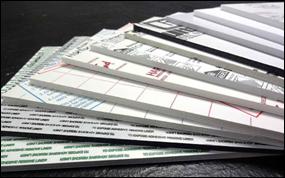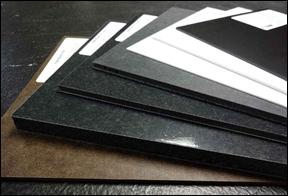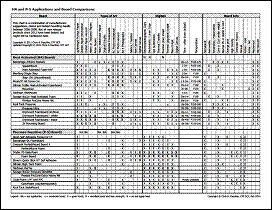 Photo 1
Photo 1
Adhesive (L) has a definite pattern while the coating (R) is smoother. Thin images can allow orange peel to show through after mounting if the adhesive does not flatten when melted.
Adhesive coated boards have become quite commonplace in today's framing industry. Heat-activated and self-adhesive pressure-sensitive products seem to dominate the market over more traditional tissues plus board of choice. Original dry mount tissues and films from pre-1945 were shellac based and often bonded at temperatures over 200ºF. Reformulations and use of synthetic adhesives since the 1970s have brought average tissue temperatures down to 185ºF-190ºF. Then came heat activated boards. In 1992 Hunt Manufacturing launched SingleStepTM using Seal Products adhesive and their Bienfang® foam board as the first heat activated substrate.
Heat-Activated Boards
HA foam center boards are an extruded polystyrene core substrate with clay coated or neutral pH facing papers that have adhesive applied to one side. Many come with slip sheets, which may be used as a single use cover sheet to keep exposed adhesive from transferring to laminator or press and to protect surface-sensitive boards during storage. The adhesive coating applications vary on products. Generally the adhesive smoothes out during bonding but occasional orange peel may occur. (photo 1)
 Photo 1
Photo 1
Adhesive (L) has a definite pattern while the coating (R) is smoother. Thin images can allow orange peel to show through after mounting if the adhesive does not flatten when melted.
Current HA boards are available as permanent, removable and reversible with temperatures running from low of 130ºF to high of 190ºF. Permanent HA boards bond in the press as all layers reach required bonding temperature and the bond may only be broken with a chemical solvent. Permanent boards—including SingleStep, Alcan Fome-Cor®, HartAct™ (formerly HartMount)—have adhesives which bond between 180ºF-190ºF with an average vacuum press dwell time of 4 minutes. SpeedMount is lower at 150ºF-160ºF as a medium temperature, short dwell time of 15-30 seconds.
Gilman MountCor® is a new true low temperature, permanent HA board which bonds at 130ºF, 30 seconds in mechanical press. It bonds at such a low temperature it is unique in the market and readily mounts all heat sensitive items including thermographics, laser prints—dry toner color copies; dye sublimation, dye transfer, thermal transfer; thermal, piezo, solvent, and UV-curing inkjet with no damage. The 130ºF temperature makes it safe for mounting all digitals.
Removable HA boards—including Bainbridge HAF, NuCor, and Kool Tack—activate as all layers reach temperature in the press, but bond outside the press as they cool under a weight. They have a moderate activation temperature of 150ºF-160ºF with a shorter dwell time of 1-3 minutes. Use in hot vacuum presses will require the draw time to be added to manufacturer suggested dwell times for these HA products.
Reversible HA boards—Restore and Preserve Ultra—have the same activation temperatures as removable boards but with a shorter dwell time of 150ºF for 15 seconds to 1 minute in a mechanical press. Reversible boards have a much lighter bond and art may be removed from the substrate and returned to its original state with no adhesive absorption or residue left behind. There are only two truly reversible HA boards, Bainbridge Artcare Restore and Kool Tack Preserve Ultra (which has been reformulated from Preserve and Acid Free Foam Boards). Even with reversible bonding, KoolTack still does not consider their board a true archival or conservation product.
For any HA board to bond properly it should have tear strength once fused. That means the top layer of adhesive and paper should rip from the board if dry peeled after mounting. Though porous paper is expected to bond well to all boards, Bainbridge HAF, Alcan HA Fome-Cor, and Gilman InSite all excellently held polyester encapsulated maps as well. Add MountCor, KT Drymount, SpeedMount and HartAct to that list for RC photograph bonding. (Photo 2) When it comes to lightweight fabrics only HAF, SingleStep and HA Fome-Cor held lightly at best and nothing tackled digital canvases well at all. Kool Tack was very aggressive with tear strength for light, heavy and coated papers, RC traditional and digital photos, but not for fabrics or canvas.
 Photo 2
Photo 2
This polyester encapsulated map tears the top layer of adhesive and paper from the board after mounting giving the HA board great tear strength.
High Density HA Substrates
High density (HD) board are becoming more popular with the demand of larger substrates, wide format printing and rollers. Because of their density these boards have longer dwell times than the above HA foam boards at 35-45 seconds and moderate temperatures of 150ºF-160ºF and neutral pH neutral adhesive. Kool Tack Mighty Tough compares to Gator™ board for its rigidity, smoothness and warp resistance, and is available up to ½" thick, 48x96". Kool Tack GATOR™ board is available 3/16" thick to 48x96".
Kool Tack Competition Plate HA, comparable to Dibond or Alucobond aluminum composite material (ACM) plus adhesive, is a 3mm thin ACM which is half the weight of aluminum and easily cuts with Fletcher Terry 3000 multi wall cutter. It activates at 160ºF-170ºF for 2-3 minute—slightly higher temp and longer dwell. Kool Tack offers Competition Plate as both HA and P-S.
Paper Core HA Boards
For correct bonding to occur in any press all items in the mounting package must reach full bonding temperature (160°F) for the designated time (30 seconds) for the bond to be made. Since foam core is an insulator rather than a conductor of heat and only the release material, art image, adhesive and top surface paper needs to reach bonding temperature, foam center boards bond at slightly lower temperatures with shorter dwell times—duration within the press under heat—than paper core boards. There are .048"-.050 thin HA "archival", alpha cellulose, and rag boards along with non-preservation grade substrates which are economical and cost effective for production operations and when prints and photos are to be fitting into a maximum ⅜" rabbet.
Pressure-Sensitive Adhesives
Self-adhesive—also known as self-stick, peel and stick, sticky—boards are cold mount pressure activated mounting substrates with thermoplastic adhesives known as P-S and PSA. They are dry, synthetic adhesives that are clean, easy to use, odorless and use no solvents with neutral pH, chemically inert adhesive. P-S boards are available as high tack and repositionable low tack versions—which cure to maximum bond under weight after roller application or burnishing.
There are three levels of tack available with pressure-sensitive adhesive: high, medium and low tack. High tack is aggressive and most difficult to manually apply since it has no repositioning potential, and immediately grab to smooth nonporous or coated stock with no forgiveness. Medium tack is the one most frequently used in picture framing. It may be somewhat repositionable during mounting with porous papers, but even repositionable p-s boards will grab more aggressively to a smooth or coated material. Low tack is most often found as a temporary positioning tack used in preparation for other bonding as laminates with liners or post-it notes, and are not suitable for the longevity of framing.
Self-Adhesive Boards
Application and end use temperature effects p-s bond permanence. And moisture is a physical barrier to adhesion and long term bonding. A permanent, high tack pressure-sensitive applied at room temperature may fail at freezing temperatures if placed outside, or in an excessively humid bathroom. Coldness to the touch is an indicator of moisture content in boards making dry storage imperative for p-s materials, if boards are damp, permanence is threatened. Remember, just as removable pressure-sensitives may not always remove, permanent pressure-sensitives may not always be permanent.
Most p-s boards have inert, stable, neutral pH adhesives applied to a selected substrate and require weighting 12-24 hours after burnished or rolled application for a fully cured bond. Bainbridge Self Adhesive Foam and Mount Boards are initially repositionable curing to permanent after weighting. Crescent Perfect Mount® Boards are repositionable and available on standard cream, solid black or foam board with adhesive on buffered surfaces. EnCore® Premium Tac repositionable board may be adjusted, removed, and reapplied for accurate placement, then set through rollers or firmly burnished to activate and cure. Alcan Fome-Cor® Self Adhesive Foam Board is available in repositionable Low Tack (LT) or immediate bonding Hi Tack (HT), both having a smooth surface. (photo 3)
 Photo 3
Photo 3
(fanned L-R) Foam center P-S boards: Gilman (LT and HT), Alcan (KLT and HT), HarTac, Elmer's, United Industries (black and white), Coda (Foam and ¼" Plastic coated Coda-Foam), Bainbridge.
As mentioned above high tack boards have more immediate grab. EnCore® SA Foam Board is a permanent pressure-sensitive adhesive with double clay coating in 3/16" as white and Black-On-Black® Foam Board. Gilman HT Self Adhesive Foam board is faced with clay coated paper and high tack pressure-sensitive adhesive that becomes permanent after curing. Hartman HarTac™ is a permanent p-s adhesive mounted to foam board that cuts easily with a utility knife, has a memory and will maintain its thickness when pressure is applied.
Paper Core SA Boards
Cardboard mounts are made of natural paper fibers which are hydroscopic allowing them to absorb and give off moisture in response to environmental humidity. This change in moisture content causes cardboard to expand and contract so once a print has been mounted on one side of a cardboard mount it can result in a bow or warp in the board. This effect becomes more pronounced as the size of the board is increased. Styrene sheets are an excellent alternative to traditional cardboard mounts. (photo 4)
 Photo 4
Photo 4
Paper core boards: Bainbridge, Savage FilmTax, PerfectMount X and XX, Coda single and double weight.
Orange peel occurs with some paper core p-s products such as PerfectMount XX and Savage FilmTax. As with most thin mount boards Cold-Mount® Single Weight—a 40 point 1/16" thick cardboard mount—and Double Weight—an 80 point ⅛" thick cardboard mount—are only suitable for mounting smaller prints because the fiber core is affected by changes in moisture content and may warp or bow.
High Density SA Boards
Gilman Self-Adhesive Ryno Heavy-Duty (HD) foam board is dense, moisture-resistant, high density foam with double thick liners available in white and black, 4x8", ¼" thick and larger. The pH neutral surface contains UV inhibitors to reduce yellowing and resists moisture absorption for extra warp resistance. (photo 5)
 Photo 5
Photo 5
Coda hardboard, countermounted Gator ½" and ¼", Gator, Coda Styrene in assorted thicknesses and colors.
Gatorboard® is a multi layer composite of extremely dense and durable polystyrene foam that resists crushing, denting, bending or warping, though can puncture or fracture if receiving a direct hit. The exceptionally rigid, smooth surface is uniform and may be lightly sanded for a blemish free finish. It has a light, durable core of polystyrene foam, bonded on both sides to wood fiber veneers impregnated with a resin for durability and moisture-resistance. It may be cut with basic woodworking tools, won’t tear, chip, or shred. Coda Cold-Mount® Gatorfoam ½" and Cold-Mount® Hardboard—a ⅛" thick wood product with two smooth, tempered surfaces—are two other HD alternatives. Also KoolTack is launching their new P-S InstaMount line which includes Composition Plate, Gator, Mighty Tough and foam. (photo 6)
 Photo 6
Photo 6
New Insta Mount PS boards series from KoolTack, including Competition Plate.
Pressure-Sensitive PVC
Styrene mounts have no natural fibers in them, are not affected by variations in moisture content in the environment, remain stable, flat, and warp free even when they are subjected to large changes in humidity, and are less prone to edge and corner damage. That said, selected styrene substrates must still be thick enough to support large, oversized images. They Coda Cold-Mount® Styrene is available as .040" (about 3/64", 1mm) and .080" (about 3/32", 2mm) thick white plastic sheet coated on one side with permanent Cold-Mount® pressure sensitive adhesive.
Sintra and Komatex are solid, all-plastic PVC boards, available in assorted thicknesses, sizes and colors for roller mounting prints, photos and digitals. Komatex® compares to Sintra® as both are closed-cell, expanded plastic, high-density poly vinyl chloride (PVC) sheets, which are neutral pH, with minimal out gassing for long term preservation use. Sintra is a homogeneous material that allows the ease of cutting without regard for grain. It is available in 9 thicknesses form 1mm-13mm in white, black & colors.
CodaFoam® is a foam center board coated on both sides white PVC plastic shell. Cold-Mount® Precoated CodaFoam is stiffer than standard foam, PVC sealed and cannot absorb moisture making it less likely to warp, and is available ⅛" and ¼" thick. United Industries Ultra Core Peel N' Stick boards are rigid, warp and dent resistant, lightweight digital imaging panels, with poly-coated white and black papers over extruded polystyrene core.
Final Mount
Whether HA or SA board is selected one should never choose by price. Though cost is definitely a consideration it remains only one of the factors in the decision making equation. Consider roller vs. press, size requirements, weighting and curing time, long term bond permanence, thicknesses and rigidity. As you can see…price is only one element.
END
Copyright © 2014 Chris A Paschke
 Photo 7
Photo 7
Many of the boards covered in this article have been tested and the results may be seen in the chart HA-PS comparisons-201402 as a full sized PDF available on this library website.
Resources—Items
http://www.artgrafix.com—SA Sintra, SA Komatex, SA Gator, Gilman, Elmer's
http://www.artsupply.com—Alcan Elmer's, Gilman, United Industries
http://www.foamboardsource.com—SA Gator, SA Sintra, SA Ryno, HA boards
http://www.foamcoreheaven.com—SpeedMount, HAF;
http://www.kooltack.com—HA and SA boards
http://www.codamount.com—SA Foam, Board, Gator, Hardboard and Styrene
For more articles on mounting basics look under the mounting section in Articles by Subject.
Additional information on all types of mounting is found in:
The Mounting and Laminating Handbook, Second Edition, 2002,
The Mounting And Laminating Handbook, Third Edition, 2008 and
Creative Mounting, Wrapping, And Laminating, 2000 will teach you everything you need to know about getting the most from your dry mount equipment and materials as an innovative frame designer.
All books are available from Designs Ink Publishing through this website.
Chris A Paschke, CPF GCF
Designs Ink
Designs Ink Publishing
785 Tucker Road, Suite G-183
Tehachapi, CA 93561
P 661-821-2188
chris@designsinkart.com